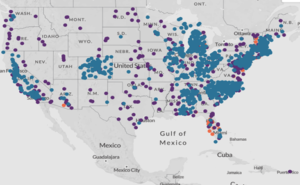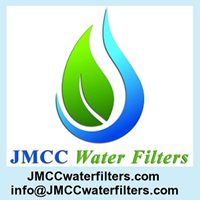Most people believe that the water they use in their homes is okay. They build beautiful homes, perhaps even filled with energy efficiency and air quality considerations, but rarely think about the water quality in their dwelling. The reality that often goes overlooked due to its not-as-obvious effect is that our water in the U.S. is, in fact, contaminated, and this contamination can represent a long-term health hazard for all of us.
The Water in our Homes
Clothing, products and food packaging, Teflon and other nonstick pans, stain-resistant products such as carpets and furniture, and fire fighting foam are all made with polyfluoroalkyl (PFAS). Dubbed “forever chemicals” because they cannot break down over time, their resistance to grease, oil, water, and heat allows them to accumulate in the environment and us. We find these chemicals increasingly in our water.
At extremely small levels, these chemicals cause adverse effects in the liver, heart, hormone and immune systems, reproductive organs, and fetal development. In a 2019 CDC study and report on Human Exposure to Environmental Chemicals, researchers found PFAS in the blood and urine of virtually all of the volunteers tested.
An interactive map of PFAS contamination created by the Environmental Working Group (EWG) as of August 2021 tells the story of PFAS contamination in 2,854 sites in 50 states and two territories. That’s only part of the story. Federal regulators have failed to act. There are no regulations in place to prevent PFAS contamination nor to correct the damage already done.


There is, fortunately, new interest in dealing with PFAS. What the government is doing:
- In 2019 the agency released a PFAS action plan; however, it did not include deadlines for action
- The Safe Drinking Water Act (SDWA) enables states to set their own drinking water standards as long as they are as stringent as the EPA’s
- In March 2021, the EPA indicated it would regulate the two worst drinking water PFAS
- In 2021, a bill passed the house that requires the EPA to establish national drinking water standards for PFAS. The EPA added 175 PFAs to the Toxics Release Inventory in response to the bill and also released a PFAS Strategic Roadmap that accelerates setting standards for PFOA and PFOS by 2023
- Actual standards are likely at least five years out
Let’s look at five different aspects of how you use water in your home—and the current status of each.
Drinking-Water
Is the water in your house truly drinkable? Just about every source outside of the regional water provider and the EPA says that it is not. The EWG map of PFAS previously mentioned shows where the contamination is most prevalent. As of mid-2021, the EPA has only established “health advisory levels” for PFAS compounds—so they are free to exist in our drinking water. Most people that add filtration do so for their drinking water alone, using systems that don’t yet address other aspects caused by PFAS.
Shower and Bath
What is shocking for most people to consider is that the most significant onslaught of toxins hits us when we shower. Our skin is the largest organ in our body, and our lungs contain more surface area. Between the water hitting our skin and breathing in toxins as vapor, these toxins never hit the purifying capabilities of the liver and kidneys and instead go directly into our blood and cells, accumulating for months, years, and decades.
On-the-go Water
We tend to turn to bottled water for convenience and safety when we believe that our tap water may be unsafe, has an unpleasant odor, or is not running clear. In a recent Civilian Exposure article, citing a Consumer Reports study of 47 bottled water brands for PFAS content, testing focused on 30 PFAS chemicals and four heavy metals—arsenic, cadmium, lead, and mercury. The study found that two of 35 noncarbonated waters tested exceeded the 1 part per trillion threshold currently recommended, one of the two coming in at 4.64 ppt. Seven of 12 carbonated brands tested exceeded the threshold, with the highest being 9.76 ppt.
Does it All Come Out in the Wash?
When we wash our clothes with filtered water, we eliminate the harmful effects of chlorine on our skin when we wear the clothes. This also minimizes the fabric from breaking down and fading. Given the use of chemical-free and contamination-free for laundry, our clothing is not only cleaner, but it also stays in great condition much longer. With filtered water, we make sure that dirt, chlorine and other chemicals, and grime are the only things that come out in the wash—not the brightness of our clothes or the disintegration of the fabric.
The Protection Myth of a Water Softener
Many believe that using a water softener protects against toxins. Not so. Water softeners do precisely what they are supposed to do if you are in a hard-water area, remove calcium and magnesium minerals to prevent limescale that clogs plumbing, mineral deposits on dishes and appliances, scratch clothes, and dry skin and hair. To remove the long-list of toxins/chemicals, however, a whole-house water filtration system is the only thing that will work.
There’s a solution—The MR5
There is a solution, and a pretty simple one that addresses what can be considered the third most important aspect of the building you call home, your water quality. By using an MR5 whole-house water filtration system, the water that comes out of your faucet, goes into your washing machine, and sprays out of the shower or bath, will be toxic- and chemical-free. The MR5 uses ultra-fiber, a series of layered meshes comprising the outside shell technology. Inside this layer is the medium that extracts all heavy metals, chemicals, and toxins. The targeted toxin filtration system specifically addresses PFAS, chemicals, volatile organic chemicals (VOCs), glyphosate, nitrates, agricultural runoff, and toxins. The MR5 removes viruses at 100 nm and zaps anything smaller with an optional UV-post filter.
Benefits include:
- Drinking water that is toxin-free, odorless, and tastes good
- Showers and baths that no longer enable the absorption of PFAS, chemicals, and toxins into your skin and lungs
- On-the-go water that can be provided directly from the tap, eliminating both the cost and the little-known long-term effects of purchasing bottled water
- Clothing will keep its color and shape, no longer disintegrating from residual chlorine and chemicals
- If your water is hard, use a water softener—but if not, it has no use in removing toxins
The MR5 whole-house filtration system is available with the optional UV-post filter. It will cost less than $1,700 plus the cost of a plumber to install it. The most important reason to purchase an MR5 Whole House filtration system is the long-term health of you and your family. If you are a homeowner, builder, architect or plumber, you should include this in your plans to assure that your homes meet the three important aspects of a healthy home – Energy Efficiency, Clean Air and Point of Entry Clean Water. To purchase the MR5 system and accessories click here –> MR5 Purchase here
